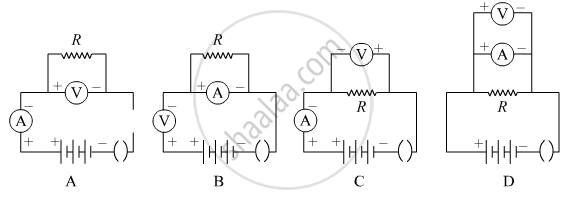Advertisements
Advertisements
Question
Find out the following in the electric circuit given in Figure
- Effective resistance of two 8 Ω resistors in the combination
- Current flowing through 4 Ω resistor
- Potential difference across 4 Ω resistance
- Power dissipated in 4 Ω resistor
- Difference in ammeter readings, if any.

Solution
- Both 8Ω resistors are connected in parallel so the effective resistance of the two will be
`1/"R"_"P" = 1/"R"_1 + 1/"R"_2`
`1/"R"_"P" = 1/8 + 1/8`
`1/"R"_"P" = 2/8`
`1/"R"_"P" = 1/4`
Rp = 4Ω - Net resistance of the circuit will be
Rnet = 4 + 4
Rnet = 8Ω
So, current in 4Ω resistor using Ohm's law is
`"I" = "V"/"R"_"net"`
`"I" = 8/8`
I = 1 A - Potential difference across 4Ω resistor is
V = IR
V = 1 × 4
V = 4 V - Power dissipated through 4Ω is
P = i2R
P = 12 × 4
P = 4 W - Both ammeters A1 and A2 will record same readings because they are connected in series. Hence difference in their readings will be zero.
APPEARS IN
RELATED QUESTIONS
What is meant by saying that the potential difference between two points is 1 V?
How much work is done when one coulomb charge moves against a potential difference of 1 volt?
Keeping the potential difference constant, the resistance of a circuit is halved. By how much does the current change?
Calculate the power used in the 2 Ω resistor in each of the following circuits: a 4 V battery in parallel with 12 Ω and 2 Ω resistors.
A current of 1.6 mA flows through a conductor. If charge on an electron is –1.6 × 10-19 coulomb, find the number of electrons that will pass each second through the cross section of that conductor.
Water in the waterfall flows from a higher level to the lower level because of ____________.
Three electric cells of potential difference 1.5 V each have been connected as a battery. The potential differences of the battery will be ____________ V.
Which one of the following is the correct set-up for studying the dependence of the current on the potential difference across a resistor and why?

State Ohm’s law.
Find the potential difference required to flow a current of 300 mA in a wire of resistance 20 Ω.
